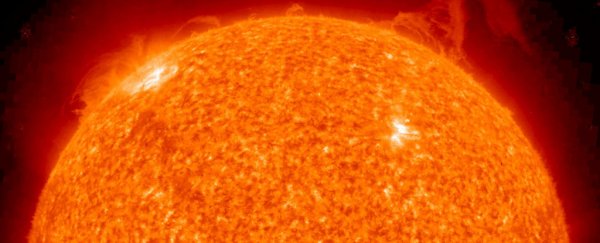It's called the Palaeocene–Eocene Thermal Maximum (PETM): a monumental and mysterious global warming event that scientists have never been able to fully explain.
Well over 50 million years ago, this epic climate abnormality produced a massive injection of carbon into the atmosphere. The build-up lasted some 20,000 years, and sent global temperatures soaring by as much as 5 to 8°C – a planetary hothouse that took up to 170,000 years to cool down.
Scarily, the PETM, like other extreme heating episodes in Earth's ancient past, is considered an analogue for the anthropogenic climate change we see unfolding in the world today.
But while Earth's current predicament can be attributed squarely to human activity, the mysterious origins of the PETM's heatwave have never been totally understood. What triggered it?
In a new study, scientists say they have an answer: Earth's orbital eccentricity in a Solar System defined by chaos.
According to oceanographer Richard Zeebe from the University of Hawaii at Manoa and geoscientist Lucas Lourens from Utrecht University in the Netherlands, the PETM occurred close to an 'eccentricity maximum' in Earth's orbit of the Sun.
In other words: a point where, during an epic 405,000-year astronomical cycle, Earth most clearly deviated from a perfect circle in orbiting the Sun, inviting world-changing consequences if the eccentricity exposed Earth to more solar radiation.
"If we look at the past 100 million years, we see distinct relationships between changes in eccentricity and climate," Zeebe told Discover.
To reach their conclusion, Zeebe and Lourens analysed sediment from deep-sea drill cores extracted from the South Atlantic Ocean.
The analysis suggested that the sediments dated to approximately 58-53 million years ago, spanning the late Paleocene and early Eocene.
When examined, the composition of sediments like these can indicate evidence of historical climate change, which in turn can point to variations in Earth's orbital position at the time.
Using these methods – a comparison of astronomical number-crunching and sediment analysis – the researchers found an exceptional match: one that allows us to peer back a whole 8 million years further on what's called the 'astronomical time scale'.
The astronomical time scale is a kind of theoretical calendar that defines geological ages with reference to astronomy – but the chaotic movement of gravitationally bound bodies in space limits the ability of this time scale to accurately peer back further than about 50 million years.
"The Solar System's chaoticity imposes an apparently firm limit of ~50 million years before the present on identifying a unique orbital solution, as small differences in initial conditions and parameters cause astronomical solutions to diverge around that age," the authors write in their paper.
But the new research lets us peer back further. A set of astronomical and physics-based calculations which the team calls astronomical solution ZB18a ended up matching the geologic data drilled from under the South Atlantic.
The authors say this match means we now have a "new absolute astrochronology" that lets us study the Solar System's moving parts as far back as 58 million years ago.
The methodology not only hints at what triggered the PETM, but might be able to tell us many other things besides – such as a new date for when the Palaeocene transitioned into the Eocene (56.01 million years ago, the team thinks).
It's possible even that one day these new findings might let us assess astronomical arrangements even further back in time, as palaeoclimatologist Linda Hinnov from George Mason University, who wasn't part of the study, told Scientific American.
"We've been waiting for someone to do something like this for some time," she said.
The findings are reported in Science.
